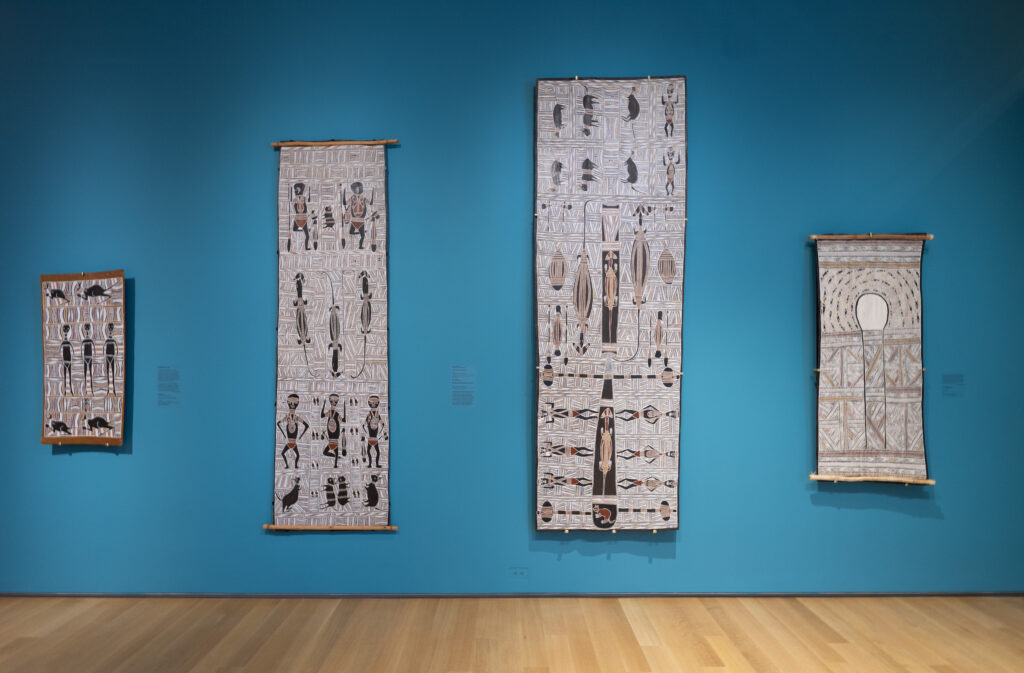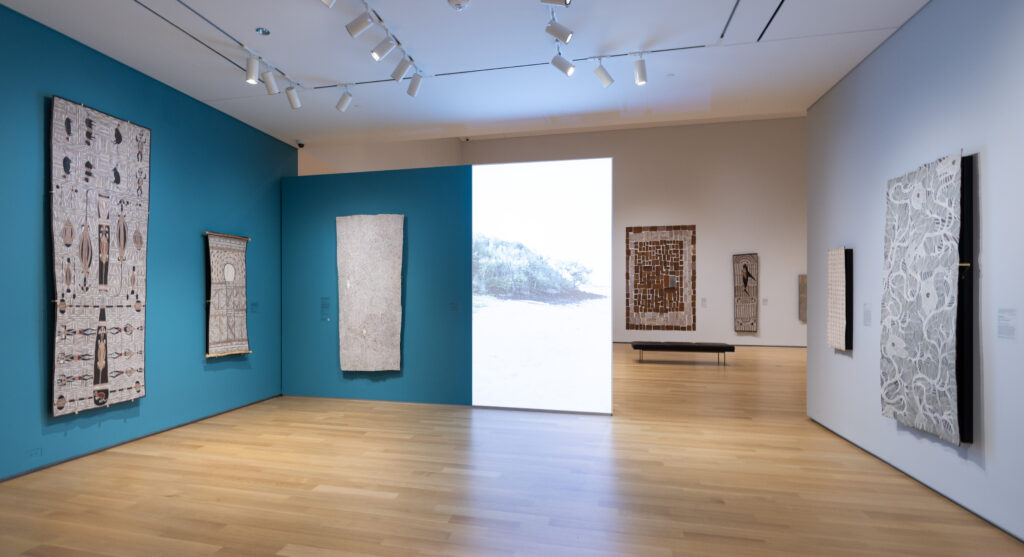
An illuminated wall of lapping sea water beckons at the entrance to MADAYIN at the Hood Museum of Art. Sounds of foamy waves overlaid with Indigenous voices singing is an irresistible invitation into a slower, richly complex world.
Just home from three days of art and culture-immersive events for the MADAYIN opening, my thoughts return to that entry space, and a concept expressed by Yolŋu curator, Mr. Wanambi, who likened viewing bark paintings to looking at the water’s surface, knowing there are unseeable depths, yet remaining content in the liminal space.
In my 2 years as a Kluge-Ruhe guide, I’ve become accustomed to discussing this duality in Australian Indigenous art, whereby the works reveal, and simultaneously conceal. Now having “skimmed the water’s surface” of the MADAYIN project, I see this duality as metaphor for the museum volunteer experience itself. On the surface, there’s alluring beauty in the art on our Pantops mountain farmhouse walls; and behind the scenes, unbelievable dynamism and activity buzzes, boldly projecting this art and culture to a much wider audience.
In truth, bark painting wasn’t a genre that readily drew me in. MADAYIN is, within the museum’s physical walls where I operate – both too big for those walls, and somewhat invisible on a daily basis. As a volunteer, I felt challenged in how to meaningfully engage.
It took time; but I was curious. I took advantage of moments like observing conservators preparing barks for MADAYIN , and chatting with collections manager and registrar Nicole Wade about the rigors that months of touring and fluctuating humidity conditions entail. I read, engaged with online content, listened to podcasts. Slowly I came to see what this massive endeavor signifies.
When Margo asked me, in my professional capacity, to handle travel logistics for the elders and artists coming from YIrrkala for the Hood’s opening, I was honored. Then came the opportunity to attend, meet the distinguished Yolŋu, and fold into the wider museum community.
It was both a huge responsibility – to the traveling delegation – and a privilege, to be present at the culmination of this monumental 7-year achievement for the museum. The Yolŋu-led opening ceremony of song, sounds of the yidaki and bilma, and beckoning of guests up the entry-way stairs into the exhibit was powerful.
I wondered how the travel-weary Yolŋu who’d journeyed so far felt to see their works, and those of their forebears, aunties and uncles, expertly displayed – all purposely arranged according to their culture’s twin moieties and distinct clan designs, as they would encounter them back home.

At dinner I sat with DJ Marika, the delegation’s ‘youngster’, making his first trip to the US. A performance artist and grandson of legendary Yirrkala artist and activist Wandjuk Marika, DJ was the featured yidaki player for the Hood events. His yidaki bore wide yellow, red and black bands of tape, the colors of the Aboriginal flag. The tape also served to protect the instrument from changing humidity conditions DJ knew he would encounter on the journey.
I recall that saying, “the medium is the message.”
This exquisite bark medium is truly a revered messenger. The majestic barks in MADAYIN both shimmer and sing. Their presence in the US is a generous invitation to glimpse the complex world of a small community of ancient people who, speaking through their art with power and authenticity, patiently altered the course of their continent’s history.


